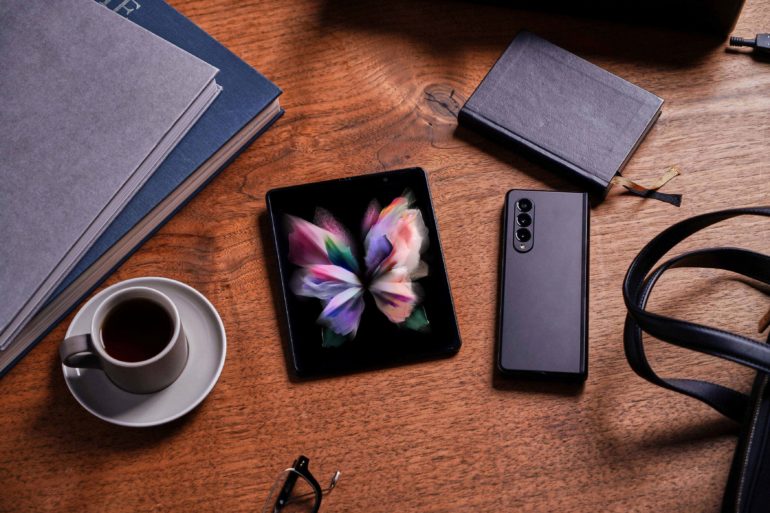Samsung’s new folding phone, $1,799 Galaxy Z Fold 3, launches on Friday. I was unimpressed with the first two models, but after testing this one for two weeks, I kind of love it. There are still too many compromises for most people — particularly battery life and the thickness of the phone when it’s shut — and it’s expensive. But I am increasingly convinced Samsung is on to something.
Samsung’s foldables had a rocky start. The first model was delayed after units sent to reviewers broke. The second version was much better. This year’s Z Fold 3 adds more refinements: It is more durable, water-resistant (but still not dust resistant), and supports a stylus for the first time. It also costs $200 less than last year’s model.
Samsung seems to be making a serious bet that foldable phones find a market. It’s launching two sizes, including this one and the Galaxy Z Flip 3 model, which is more like a regular phone that folds in half.
Like it did with the large-screened Galaxy Note, which was one of the first large-screened phones with a stylus, it’s establishing a foothold in a new market long before Apple. By improving its screens year to year, it can have them ready to sell to other phone makers. As prices continue to drop, Samsung will be ready if consumers decide this is the next big trend in phones.
Here’s what you need to know about the new Galaxy Z Fold 3.
What’s good
I like that Samsung’s experimenting with fun designs. A lot of the recent progress in phones has been in incremental improvements to network speeds, camera quality and displays. But phone design has remained relatively similar since Samsung first introduced big-screened “phablets” with its Note series in 2011. (Now those big screens are standard — the screen of Apple’s current iPhone Mini is actually bigger, at 5.4 inches, than the first Galaxy Note, which measured 5.3 inches.)
I enjoyed being able to just sit on the couch at night and pull a small tablet out of my pocket, instead of searching for my iPad and hoping it had a charge. The software is getting a lot better, too. The Google Chrome browser, for example, lets you tap through tabs like you would on a traditional tablet or computer.
You can force apps such as Instagram to resize and use the full screen, which you couldn’t do last year. And I liked that I could run several apps side by side or in multiple windows. It’s convenient to chat with friends in one app, having Twitter open next to it, and watching a movie floating on top of everything.
Samsung also improved the phone’s durability. With new changes to the screen and the protector on top of it, the combined display durability is now 80% stronger than before. There’s still some flex when you push down on the screen, but it’s a lot better than the first version, which felt too weak. Samsung also made the phone IPX8 water-resistant, which means you won’t have to worry about damage in the rain but should still avoid taking it anywhere where dirt or dust could get into the hinge and behind the screen. So far, I haven’t had any problems.
I also like that you can start doing something on the front screen and then continue doing that on the larger inside display. So, if you search for a coffee shop in Google Maps on the outer display, for example, and then open it, you’ll see a huge Google Map waiting for you. It works well for movies, if you want to start one with the phone propped open on your desk and then continue watching it on the bigger inner display.
This is the first folding phone from Samsung with support for its S Pen. The company didn’t introduce a new Galaxy Note phone this year, instead opting to add support for its stylus to the Galaxy Z Fold 3. But, you need to buy a $49.99 special version of the S Pen with a tip that retracts so you don’t push too hard on the screen. Also, there’s nowhere to store the pen, so you just have to keep it in your pocket or buy a $79.99 case with storage for the pen.
It works well, despite the crease in the middle. I wish it worked as previous S Pens did, though, with the option to control media or the camera shutter with the S Pen’s button. Instead, it’s best for just navigating on the screen, drawing or writing notes. I found it most useful for signing the occasional document.
Ultimately, I just really like that this phone is so different from anything else out there, and I haven’t (yet) had to worry so much about it getting damaged. It’s just fun. But it’s definitely not for everyone, and there are still a lot of compromises for the price.
What’s bad
There are two big drawbacks to the Galaxy Fold 3: Thickness and battery life.
It’s still chunky, even folded closed. Yet, the outside screen still felt a little small when I was trying to send emails. I made more typos. So I found myself using the bigger screen most of the time.
Unfortunately, it takes a lot of power to keep the 7.6-inch screen running. I found I mostly got about four to four-and-a-half hours of screen time on a charge, which isn’t a whole lot. I fully charged it, then surfed Airbnb for a place to stay on vacation and, two hours later, the battery was at 50%. It’ll last much longer if you’re not using that big screen, but that’s sort of the whole point of the phone. It does charge pretty quickly, but you’ll want to keep a battery pack or at least a charger in your bag.
Also, yes, there’s still a crease in the middle of the screen. It’s annoying for a couple of days, but it starts to sort of blend in, and it’s hard to see when you’re looking directly at the phone with the brightness up. I think Samsung needs to get rid of the crease before it goes mainstream. Most people used to traditional phones will probably be put off by it.
The cameras are fine and you get plenty of choices, including a wide-angle, zoom and an ultra-wide-angle lens for fitting more people into a shot. But they’re older cameras that were first introduced two years ago, so you’re getting dated tech instead of the latest and greatest cameras Samsung introduced on its S21 phones earlier this year. Those cameras would have added to the cost.
Speaking of cameras, there’s a funky new under-screen camera on the big display. Samsung’s goal was to make the black camera dot less visible, and it works in some cases, such as when you’re watching movies. But you’ll still certainly see the camera if you look for it — it looks like a jumbled screen of pixels. Samsung had to make sacrifices for this. It’s a lower quality, so selfies aren’t as sharp as they could be. You can still use any of the other four sensors for selfies, but you have to close the phone to use those.
I have a few other quibbles with the phone. The speakers sound sort of tinny compared with other flagship phones, for example. And despite the increase in durability, I’m still afraid I’ll break this phone much faster than I would a regular flagship.
Should you buy it?
The Galaxy Z Fold 3 still isn’t for regular people. But it’s a great phone for gadget geeks who know what they’re getting into.
I wasn’t wild about earlier models, since I was worried about water damage in the rain or the screen breaking again. But it’s just super convenient to have a tablet for reading, movies, emails and more right in my pocket. That said, I’m a gadget geek, this is the sort of fun new tech I live for, and I know the risks and trade-offs.
Most people are still better off buying one of Samsung’s other high-end phones, like the Galaxy S21 or Galaxy S21 Ultra, which are even more durable, have better cameras, longer battery life and more. They just don’t double as a tablet.



